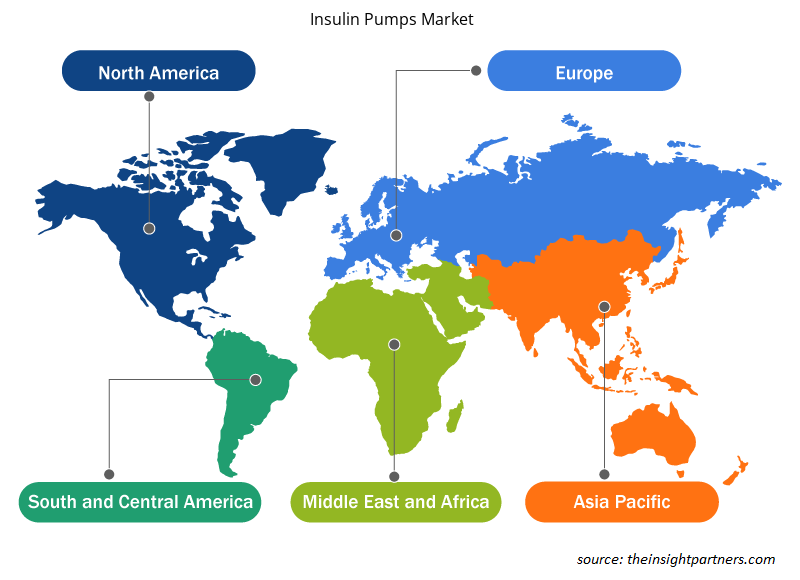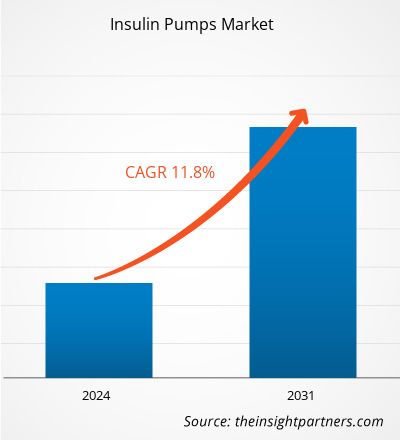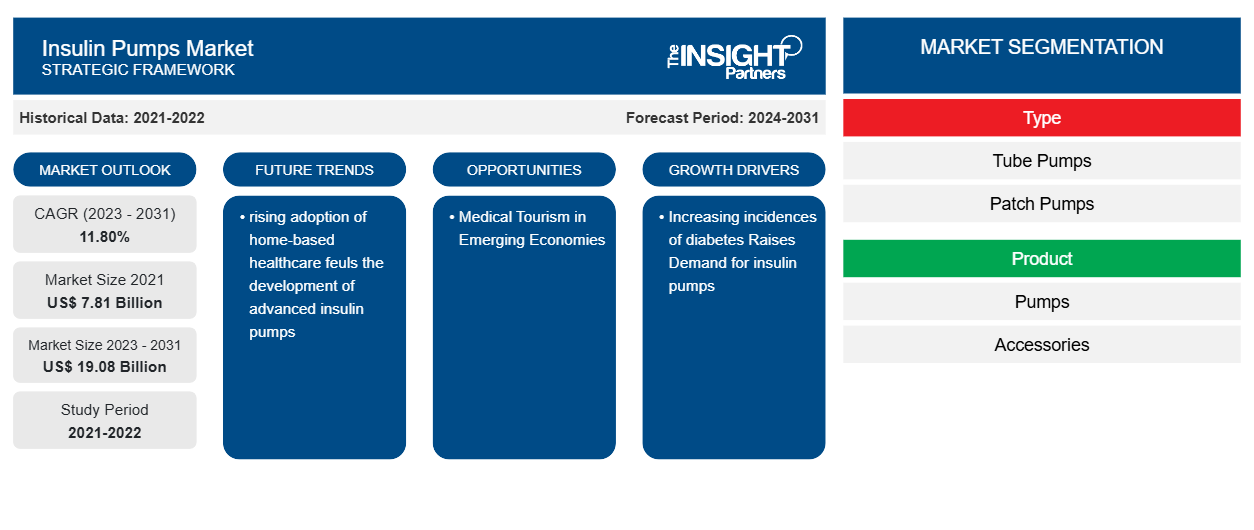Le marché des pompes à insuline était évalué à 7,81 milliards de dollars américains en 2021 et devrait atteindre 19,08 milliards de dollars américains d'ici 2031. Le marché devrait enregistrer un TCAC de 11,80 % entre 2023 et 2031. Les progrès technologiques devraient rester l'une des principales tendances du marché des pompes à insuline.
Analyse du marché des pompes à insuline
Les pompes à insuline délivrent de l'insuline, une hormone qui aide à réduire le taux de sucre dans le sang chez les patients diabétiques. L'insulinothérapie est un traitement essentiel pour les patients atteints de diabète de type 1 et de type 2. Le diabète est l'un des problèmes de santé majeurs dont la prévalence augmente rapidement. Par conséquent, il est nécessaire de diagnostiquer et de gérer la maladie à un stade précoce pour éviter d'autres problèmes tels que les maladies cardiaques. L'incidence et la prévalence croissantes du diabète et les facteurs de risque associés, notamment les changements de mode de vie, l'obésité et le vieillissement de la population, stimulent la demande de pompes à insuline sur le marché.
Aperçu du marché des pompes à insuline
Les innovations technologiques et les solutions intelligentes continuent d’influencer considérablement le marché des pompes à insuline.
L'Asie-Pacifique est le marché régional des pompes à insuline qui connaît la croissance la plus rapide. Le marché de cette région est segmenté en Chine, Japon, Corée du Sud, Inde, Australie et reste de l'APAC. La prévalence mondiale croissante du diabète, l'incidence croissante des troubles liés au mode de vie et le vieillissement de la population devraient stimuler la croissance du marché au cours des prochaines années. Les pompes à insuline sont indiquées pour la population de patients diabétiques car elles imitent la fonction d'un pancréas normal en administrant une dose d'insuline basale et des doses de bolus lorsque la glycémie dépasse la plage normale. La prévalence croissante devrait avoir un impact significatif sur la croissance du marché au cours de la période de prévision. En outre, un portefeuille de produits solide et la commercialisation future des pompes à insuline devraient offrir une opportunité de croissance future pour ce marché.
Personnalisez ce rapport en fonction de vos besoins
Vous bénéficierez d'une personnalisation gratuite de n'importe quel rapport, y compris de certaines parties de ce rapport, d'une analyse au niveau des pays, d'un pack de données Excel, ainsi que d'offres et de remises exceptionnelles pour les start-ups et les universités.
-
Obtenez les principales tendances clés du marché de ce rapport.Cet échantillon GRATUIT comprendra une analyse de données, allant des tendances du marché aux estimations et prévisions.
Moteurs et opportunités du marché des pompes à insuline
La prévalence croissante du diabète favorise le marché
Comme le souligne le rapport de l'American Diabetes Association publié en 2024, 38,4 millions d'Américains souffraient de diabète en 2021. Parmi eux, 29,7 millions étaient diagnostiqués et 8,7 millions n'étaient pas diagnostiqués. En outre, le rapport de la Fédération internationale du diabète publié en 2022 a révélé que l'Amérique du Nord et les Caraïbes représentaient 51 millions de cas de diabète, l'Europe 61 millions, le Moyen-Orient et l'Afrique du Nord 73 millions, l'Afrique 24 millions, l'Asie du Sud-Est 90 millions, le Pacifique occidental 206 millions et l'Amérique du Sud et centrale 32 millions de cas de diabète en 2021.undiagnosed. Additionally, the International Diabetes Federation report published in 2022 revealed that North America and the Caribbean accounted for 51 million, Europe accounted for 61 million, Middle East & North Africa reported 73 million, Africa for 24 million, South East Asia for 90 million, Western Pacific for 206 million, and South & Central America accounted for 32 million diabetes cases in 2021.
Ainsi, la prévalence croissante du diabète et les progrès technologiques croissants dans les dispositifs d’administration stimulent la croissance des pompes à insuline.
Le tourisme médical en plein essor : une opportunité
Les progrès technologiques dans le domaine de la santé dans les pays en développement incitent les patients à voyager pour bénéficier de traitements meilleurs et moins coûteux et les principaux acteurs à développer leurs activités. La plupart des fabricants de pompes à insuline se concentrent sur les marchés émergents tels que l'Inde, le Brésil, l'Argentine et les pays d'Amérique latine en raison de l'augmentation de la prévalence du diabète et de l'utilisation croissante de dispositifs dans la région. En Inde, la science médicale a proliféré au cours des dernières décennies. Le traitement du diabète est rentable et facilement disponible sur les marchés émergents et les personnes d'autres pays voyagent pour se faire soigner. La raison la plus probable pourrait être les dépenses de santé excessivement élevées de leur pays. En raison des taux de change existants et d'autres facteurs, le traitement du diabète en Inde est devenu abordable par rapport à d'autres pays étrangers. Ainsi, l'essor du tourisme médical dans les pays émergents comme l'Inde devrait offrir des opportunités importantes aux acteurs opérant sur le marché des pompes à insuline au cours de la période de prévision.
Analyse de segmentation du rapport sur le marché des pompes à insuline
Les segments clés qui ont contribué à l’élaboration de l’analyse du marché des pompes à insuline sont le type,
produit et application.
- Selon le type, le marché des pompes à insuline est divisé en pompes à tube et pompes à patch. Le segment jetable pourrait détenir une part de marché plus importante en 2023.
- En fonction du produit, le marché des pompes à insuline est divisé en deux segments : les pompes et les accessoires. Le segment des pompes pourrait détenir une part de marché plus importante en 2023.
- En fonction des applications, le marché des pompes à insuline est divisé en diabète de type I et diabète de type II. Le segment du diabète de type 1 pourrait détenir une part de marché plus importante en 2023.
Analyse des parts de marché des pompes à insuline par zone géographique
La portée géographique du rapport sur le marché des pompes à insuline est principalement divisée en cinq régions : Amérique du Nord, Asie-Pacifique, Europe, Moyen-Orient et Afrique, et Amérique du Sud et centrale.
L'Amérique du Nord domine le marché des pompes à insuline. Les États-Unis représentent une part considérable du marché des pompes à insuline en Amérique du Nord. La présence des meilleurs prestataires de services de santé aux États-Unis est l'un des facteurs les plus influents responsables de la croissance du marché. L'Asie-Pacifique devrait connaître le TCAC le plus élevé dans les années à venir.
Aperçu régional du marché des pompes à insuline
Les tendances et facteurs régionaux influençant le marché des pompes à insuline tout au long de la période de prévision ont été expliqués en détail par les analystes d’Insight Partners. Cette section traite également des segments et de la géographie du marché des pompes à insuline en Amérique du Nord, en Europe, en Asie-Pacifique, au Moyen-Orient et en Afrique, ainsi qu’en Amérique du Sud et en Amérique centrale.

- Obtenez les données régionales spécifiques au marché des pompes à insuline
Portée du rapport sur le marché des pompes à insuline
| Attribut de rapport | Détails |
|---|---|
| Taille du marché en 2021 | 7,81 milliards de dollars américains |
| Taille du marché d'ici 2031 | 19,08 milliards de dollars américains |
| Taux de croissance annuel composé mondial (2023-2031) | 11,80% |
| Données historiques | 2021-2022 |
| Période de prévision | 2024-2031 |
| Segments couverts |
Par type
|
| Régions et pays couverts |
Amérique du Nord
|
| Leaders du marché et profils d'entreprises clés |
|
Densité des acteurs du marché des pompes à insuline : comprendre son impact sur la dynamique commerciale
Le marché des pompes à insuline connaît une croissance rapide, tirée par la demande croissante des utilisateurs finaux en raison de facteurs tels que l'évolution des préférences des consommateurs, les avancées technologiques et une plus grande sensibilisation aux avantages du produit. À mesure que la demande augmente, les entreprises élargissent leurs offres, innovent pour répondre aux besoins des consommateurs et capitalisent sur les tendances émergentes, ce qui alimente davantage la croissance du marché.
La densité des acteurs du marché fait référence à la répartition des entreprises ou des sociétés opérant sur un marché ou un secteur particulier. Elle indique le nombre de concurrents (acteurs du marché) présents sur un marché donné par rapport à sa taille ou à sa valeur marchande totale.
Les principales entreprises opérant sur le marché des pompes à insuline sont :
- Société Insulet
- Medtronic
- Soins du diabète Tandem, Inc.
- Debiotech SA
- CELLNOVO
- SOOIL Developments Co., Ltd
Avis de non-responsabilité : les sociétés répertoriées ci-dessus ne sont pas classées dans un ordre particulier.

- Obtenez un aperçu des principaux acteurs du marché des pompes à insuline
Actualités et développements récents du marché des pompes à insuline
Le marché des pompes à insuline est évalué en collectant des données qualitatives et quantitatives après des recherches primaires et secondaires, qui comprennent des publications d'entreprise importantes, des données d'association et des bases de données. Voici une liste des développements sur le marché des pompes à insuline et des stratégies :
- PharmaSens, basée en Suisse, a déposé une demande d'approbation auprès de la FDA pour son système de pompe à patch d'insuline « niia essential ». La société a également obtenu la certification ISO 13485 en novembre 2023 pour la conception, le développement, la fabrication et la distribution du système. Le produit est une pompe à patch basal-bolus au design épuré qui combine la facilité d'utilisation d'un stylo à insuline avec les avantages d'une pompe à insuline sophistiquée. Elle est dotée d'un réservoir innovant de 3 ml, ce qui en fait l'une des pompes à patch les plus compactes du marché. Le système de pompe à patch d'insuline intègre également un mécanisme d'insertion automatique de l'aiguille et un concept semi-réutilisable pour une conception de produit rentable et durable. (Source : PharmaSens AG, communiqué de presse, 2023)
- La Food and Drug Administration (FDA) des États-Unis a approuvé la pompe Beta Bionics iLet ACE et le logiciel de décision de dosage iLet pour les personnes âgées de 6 ans et plus atteintes de diabète de type 1. Ces deux appareils et un moniteur de glucose en continu intégré (iCGM) compatible et approuvé par la FDA forment un nouveau système appelé iLet Bionic Pancreas. Le nouveau système de dosage automatisé de l'insuline (AID) utilise un algorithme pour déterminer et commander l'administration d'insuline. (Source : US FDA, Press Announcements, 2023)
Rapport sur le marché des pompes à insuline : couverture et livrables
Le rapport « Taille et prévisions du marché des pompes à insuline (2021-2031) » fournit une analyse détaillée du marché couvrant les domaines ci-dessous :
- Taille du marché et prévisions aux niveaux mondial, régional et national pour tous les segments de marché clés couverts par le périmètre
- Dynamique du marché, comme les facteurs moteurs, les contraintes et les opportunités clés
- Principales tendances futures
- Analyse détaillée des cinq forces de PEST/Porter et SWOT
- Analyse du marché mondial et régional couvrant les principales tendances du marché, les principaux acteurs, les réglementations et les développements récents du marché
- Analyse du paysage industriel et de la concurrence couvrant la concentration du marché, l'analyse de la carte thermique, les principaux acteurs et les développements récents
- Profils d'entreprise détaillés
- Analyse historique (2 ans), année de base, prévision (7 ans) avec TCAC
- Analyse PEST et SWOT
- Taille du marché Valeur / Volume - Mondial, Régional, Pays
- Industrie et paysage concurrentiel
- Ensemble de données Excel
Rapports récents
Rapports connexes
Témoignages
Raison d'acheter
- Prise de décision éclairée
- Compréhension de la dynamique du marché
- Analyse concurrentielle
- Connaissances clients
- Prévisions de marché
- Atténuation des risques
- Planification stratégique
- Justification des investissements
- Identification des marchés émergents
- Amélioration des stratégies marketing
- Amélioration de l'efficacité opérationnelle
- Alignement sur les tendances réglementaires























 Obtenez un échantillon gratuit pour - Marché des pompes à insuline
Obtenez un échantillon gratuit pour - Marché des pompes à insuline